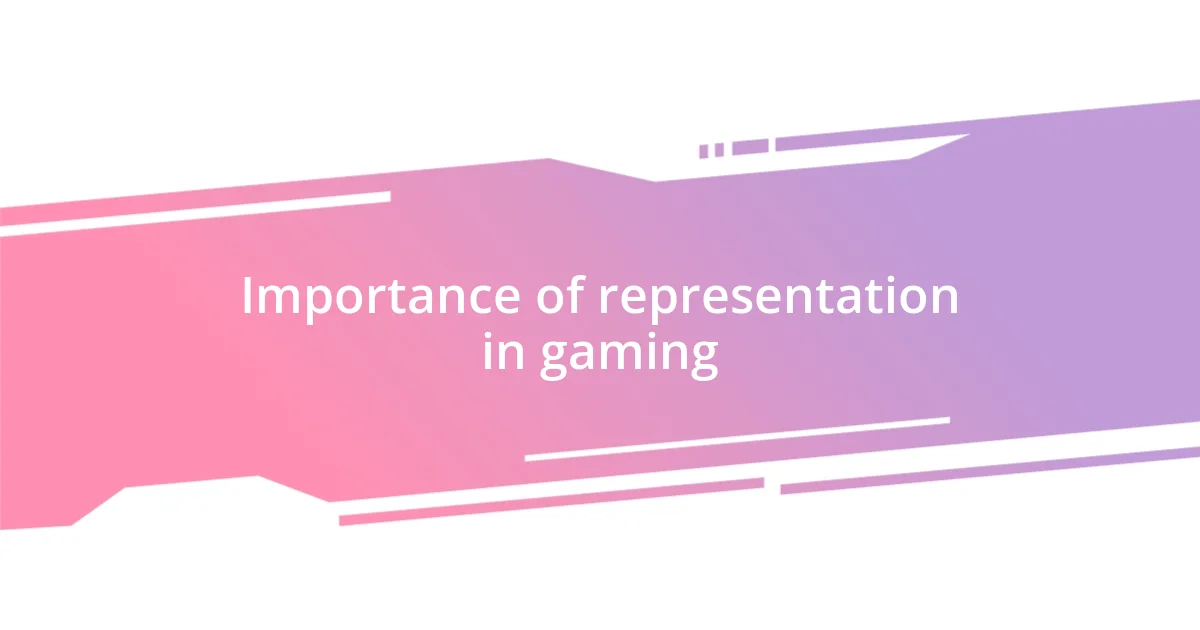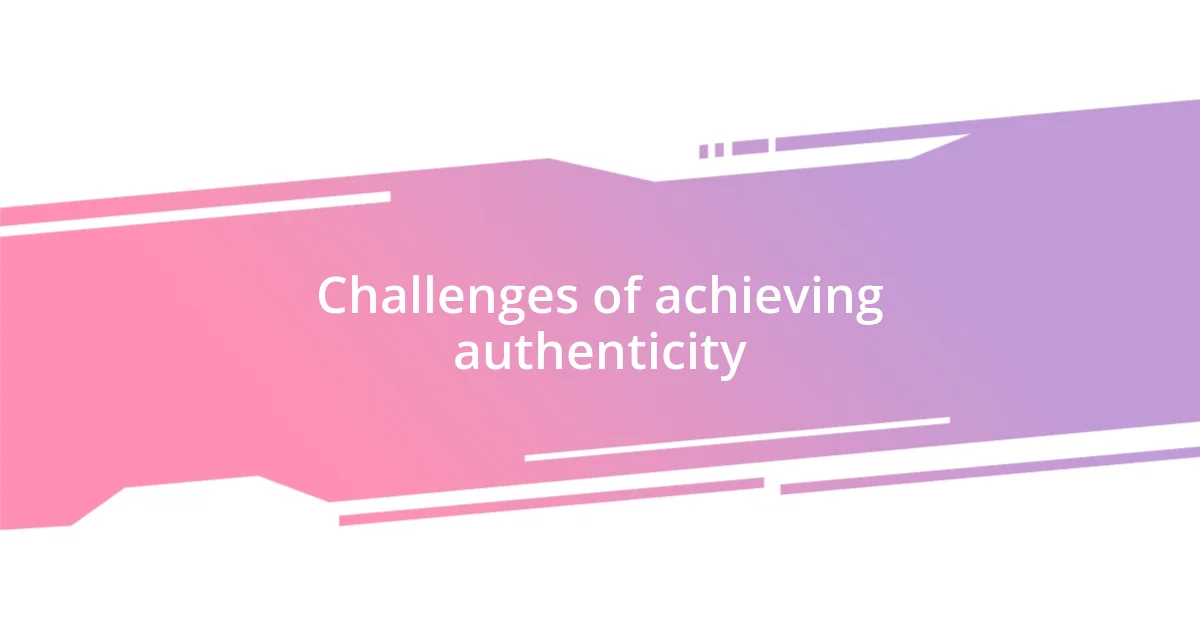Key takeaways:
- Cultural authenticity in games enhances the narrative and fosters a sense of belonging by accurately representing diverse customs, languages, and traditions.
- Challenges in achieving authenticity include differing perceptions of representation, creative constraints, and financial viability, which can lead to superficial cultural portrayals.
- Best practices for developers involve diverse team composition, iterative feedback from cultural representatives, and maintaining transparency to build trust and deepen authentic representation.

Understanding cultural authenticity in games
Cultural authenticity in games is about representing diverse cultures in a way that resonates with their true essence. Think back to a time when you played a game that authentically depicted a culture you’re passionate about—didn’t it feel like a beautiful blend of storytelling and respect? That connection often enhances gameplay, creating a deeper emotional journey.
As I’ve delved into various games that tackle cultural themes, I’ve noticed how authenticity not only enriches the narrative but also fosters a sense of belonging. When a game accurately represents customs, languages, and traditions, it invites players to step into those worlds authentically. Can you remember a game that made you feel like part of a culture you didn’t initially understand? It’s those moments when you realize the power of cultural sensitivity and appreciation within the gaming experience.
However, the line between representation and appropriation can sometimes blur. I often wonder—how can developers ensure they’re honoring the culture without crossing into misrepresentation? This complex balancing act is crucial. In my experience, games that engage with cultural consultants or communities often shine in delivering messages that feel both respectful and enlightening. Understanding cultural authenticity isn’t just about checking boxes; it’s about creating a dialogue that reflects real-world diversity.

Importance of representation in gaming
Representation in gaming is essential as it shapes how players perceive and relate to different cultures. I remember playing a game set in Japan that beautifully captured its vibrant festivals and traditions. That immersive experience opened my eyes to aspects of the culture I hadn’t encountered before. When games genuinely reflect diverse cultures, they not only educate players but also nurture empathy and understanding.
- Representation enriches storytelling, creating a world that feels real and relatable.
- It empowers marginalized voices, giving them a platform to share their narratives.
- Games with authentic representation encourage players to explore unfamiliar cultures comfortably.
- Inclusivity in gaming can foster social change, impacting how diversity is viewed in broader society.
I find that games often become a catalyst for conversations, inviting players to reflect on and appreciate cultural differences. When done right, representation transforms gaming from mere entertainment into a meaningful experience.

Challenges of achieving authenticity
Cultural authenticity in games certainly comes with its own set of challenges. One major hurdle arises from the developers’ intent versus the community’s perception. I recall a game that aimed to depict Indigenous culture but faced backlash for oversimplifying complex traditions. This made me realize that what may seem respectful to one group can be perceived as a stereotype by another. It genuinely highlights the importance of listening to the voices within the cultures being represented.
Another challenge is the creative constraints placed on developers. Often, the pressure to deliver a specific gameplay experience can overshadow cultural nuances. For instance, I remember a game where I felt the cultural backdrop was merely a decorative layer rather than an integral part of the storyline. It’s fascinating how the quest for player engagement can inadvertently dilute the authenticity that makes a cultural depiction resonate deeply.
Lastly, there’s the issue of financial viability. Developers sometimes prioritize broader appeal over cultural specificity, fearing that deep authenticity could limit their market. I once played a title that presented a vibrant cultural setting but opted for generic character designs to attract a wider audience. This blend of business strategy and artistic integrity reminds me of the constant tug-of-war developers face in their creative pursuits.
| Challenge | Description |
|---|---|
| Intent vs. Perception | Differing views on cultural representation can lead to misunderstandings and backlash. |
| Creative Constraints | Gameplay demands can overshadow important cultural nuances. |
| Financial Viability | Fears of limiting market appeal may affect the depth of cultural representation. |

Methods for researching cultural backgrounds
When it comes to researching cultural backgrounds for games, I’ve found that engaging with primary sources can be incredibly rewarding. For instance, I once spent hours diving into folklore books and community interviews for a project focused on African myths. This first-hand knowledge gave me a rich context that I wouldn’t have gathered from secondary sources alone, deepening my understanding and appreciation for the intricacies of the culture.
Another effective method is building connections with cultural consultants or members of the communities depicted. I remember reaching out to a local historian to provide insights for a game set in a region steeped in history. Not only did their perspective sharpen the narrative, but it also instilled a sense of responsibility in me as a developer—highlighting the importance of authenticity. Have you ever thought about how much storytelling can be enhanced by voices from within a community? It’s a game-changer, literally.
Participating in cultural events can also be a rich avenue for research. Attending a festival allowed me to experience traditions and values up close, which no amount of reading could replicate. The vibrant colors, sounds, and stories witnessed helped me craft an immersive setting for my project. This hands-on approach helped me understand the significance of the culture, making my representation more nuanced and heartfelt. How do you think immersing yourself in a culture could change your perception of it? I believe it’s an essential step for anyone serious about authentic representation in their work.

Collaborating with cultural experts
Collaborating with cultural experts can truly reshape the development process, leading to authentic representations that resonate with audiences. I once partnered with a cultural historian while developing a game based on Pacific Islander heritage. Their insights not only gave depth to the gameplay but also infused our characters with authenticity and respect that I might have overlooked without their guidance. Have you ever collaborated with someone who completely changed your perspective? It’s a powerful reminder of how teamwork can unlock new levels of creativity and comprehension.
In my experience, such collaborations require open-mindedness and a genuine willingness to learn. During my work on a project aimed at depicting African cultural practices, I invited a cultural advisor to our brainstorming sessions. The discussions were eye-opening; I learned nuances about social structures and traditions that directly influenced our narrative choices. I still remember how one small adjustment based on their feedback made a character’s backstory feel so much richer and more relatable. It’s amazing how one conversation can connect you more deeply to a culture, isn’t it?
Trust is a vital component of these collaborations too. I encountered this firsthand when working on a game that sought to portray Indigenous folklore. I arranged regular meetings with a consultant from the community, which fostered an atmosphere of mutual respect. Collaborating this way led to open feedback from them, making the game a shared cultural celebration rather than just my interpretation. Have you ever thought about how trust can transform a project into a collaborative journey? This harmony not only enhances creativity but also creates a platform for voices often unheard.

Best practices for game developers
Game developers should prioritize diverse team composition during the design process. I once joined a project where we were a mix of backgrounds—each contributing unique perspectives. The magic happened when we discussed gameplay elements; insights from my colleagues who had lived in various cultures led us to create more nuanced character arcs. It’s fascinating how diversity can elevate storytelling, don’t you think?
Additionally, I advocate for iterative feedback loops with cultural representatives throughout development. This approach was vital in a project where we created a game inspired by Middle Eastern mythology. By consistently looping back with cultural consultants at different phases, we could adjust elements that didn’t feel right. This continuous dialogue not only polished the narrative but also made it feel like a collective effort toward authenticity. Have you experienced how a fresh set of eyes can revitalize your work?
Lastly, transparency is key. I’ve learned that openly sharing the intentions behind my creative choices with the communities represented fosters trust. For example, while drafting a character based on traditional folklore, I held a discussion with community leaders about my artistic direction. Their candid feedback reshaped my understanding of what authenticity really meant to them, ensuring our portrayal was genuine. How often do we think about the impact of our choices on the cultures we depict? I believe this openness fosters deeper connections and enriches the gaming experience for everyone involved.














